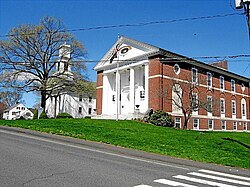Career

Clinton Smith was the architect and builder of many of the best buildings in Middlebury, Vermont, such as the court house, town hall, Methodist church, Baptist church, Beckwith block, Dyer block and many residences. [1]
His first work of consequence was the erection of Shard Villa, the stone residence in Salisbury, Vermont, of Columbus Smith. [1]

He was widely known throughout the state also in adjacent parts of New Hampshire and New York, as a builder of churches and public buildings, among them the library annex to the Capitol building in Montpelier, Vermont, and the Asylum for the Insane at Waterbury, Vermont. [1]
In 1891 he accepted a position in the War Department at Washington, D.C. as Chief of Construction and Repair under Hon. Redfield Proctor, then secretary of War in Harrison's administration, and with his family removed to the capital city. He served the government acceptably exactly fourteen years when he resigned his position partly on account of impaired health and partly from a wish to accept another position under Senator Redfield Proctor which offered him outside exercise and air of which so much desk work deprived him. His desk work, however, had been constantly alleviated by long trips to inspect buildings under construction at army posts and reservations in all parts of the United States, thus he became known to a wide circle of friends in every walk of life. [1]
His resignation took effect June 1, 1905 and he became one of the incorporators of "The Talpin Construction Co.", in Washington and began the erection of its first building a large marble apartment house Champlain Apartment Building on K street in that city. This furnished him congenial and absorbing occupation until he was stricken by an alarming illness on July 28, 1905. Two trained nurses and his family attended his bedside. All that medical skill could accomplish was employed in vain. His disease was pronounced typhoid fever of a virulent type. He suffered hemorrhage after hemorrhage yet made a gallant fight for life till weakness prostrated every faculty and he died on the evening of August 2, 1905. This was his third attack of that dread disease. The first one was at the age of 14 years, the next 10 years later. Each attack was exceptionally severe and heightened by complications. His funeral was attended at his suburban residence "Smitholm" on August 4, 1905. [1]













